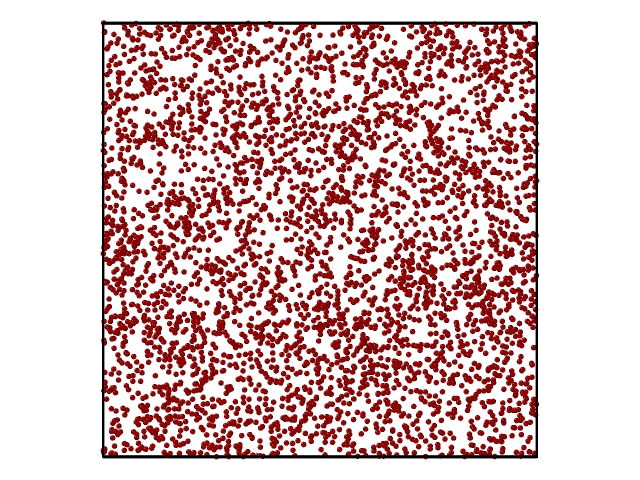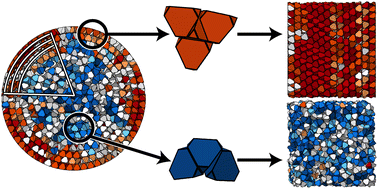“A model is a lie that helps you see the truth.”
– Howard Skipper (quoted in The Emperor of All Maladies, by Siddhartha Mukherjee)
“Spherical-cow” simplistic computational models … |
![Spherical cow [Wikimedia]](https://upload.wikimedia.org/wikipedia/commons/2/23/SphericalCow2.gif) |
Geometric frustration … |
![Geometric frustration [Wikimedia]](https://upload.wikimedia.org/wikipedia/commons/thumb/7/7a/FrustrationIcosaedre.jpg/640px-FrustrationIcosaedre.jpg) |
Methods
Soft matter self-assembly simulations


Simple “toy” model systems exhibit a striking resemblance with complex behaviors in materials, such as crystallization. We perform computational experiments on the building-block scale of various materials, using the open-source general purpose toolkit HOOMD-blue. We are on the hunt for mechanisms that drive the formation of complex and exotic ordering phenomena, as well as universal behavior that can help us understand materials in a bottom-up approach.
Complex crystal structures

Complex structures occur in all kinds of condensed matter systems: hard or soft. While the specific building blocks, length scales, and properties vary, the rules of crystallography apply across different materials classes, providing us a toolbox to work with, as well as innumerable riddles to solve. We are investigating complex crystal structures and are working on gaining insights about their stability and formation.
| → J. Dshemuchadse, “Soft matter crystallography—complex, diverse, and new crystal structures in condensed materials on the mesoscale”, Journal of Applied Physics 131 (2), 020901 (2022). |
Intermetallic compounds
Crystal structures composed solely of metallic elements feature a large variety of geometries and, while we already know about more than 2,000 different structure types, new structures are being discovered to this day. Intermetallics can serve as model systems for the wealth of different crystal symmetries and structural motifs that we hope to find in all kinds of materials. We use the in-depth knowledge that is available on intermetallics as the basis and inspiration of our exploits in materials geometry more generally.
Projects
- Decoding Crystal Growth and Phase Transformations of Complex Structures With Minimalist Self-Assembly Models (2022–2027) (National Science Foundation (NSF), Division of Materials Research (DMR), Condensed Matter and Materials Theory (CMMT))
- Coarse-Grained Growth Models for Defect- Engineered Metal-Organic Framework Structures (2023–2025) (American Chemical Society, Petroleum Research Fund, Doctoral New Investigator Grant)
- Discovery of New Self-Assembled Crystal Structures for Materials Design (2022–2024) (The Camille and Henry Dreyfus Foundation, Machine Learning in the Chemical Sciences and Engineering Award)
- Crystal Engineering via Size-Disperse Particle Self-Assembly (2021–2022) (Affinito-Stewart Grant, President’s Council of Cornell Women (PCCW), Cornell University)
Collaborations
- Integrating machine learning, materials modeling, and high-throughput experiments for the discovery of ultra-stable metal-organic frameworks for water purification (2024–2026) with Nicole Benedek, Phillip Milner, Michael Thompson at Cornell Engineering (SPROUT Awards)
- Geometric Frustration in Isomerizations of Magic-Sized Clusters (2021–2024) with Richard D. Robinson (National Science Foundation (NSF), Division of Chemistry (CHE), Macromolecular, Supramolecular, and Nanochemistry (MSN))
- Atomic Membranes for 3D Systems (2022–2023) at Cornell Center for Materials Research
- Electrospun Inorganic Tetrahelix Fibers with Reversible Optical Activity (2020–2022) with Richard D. Robinson, Tobias Hanrath, Larissa Shepherd at Cornell Center for Materials Research
- Uli Wiesner (Cornell University, Department of Materials Science and Engineering)
- Erin G. Teich (Wellesley College, Department of Physics and Astronomy)
- Chrisy Xiyu Du (University of Hawaiʻi at Mānoa, Department of Mechanical Engineering)
- Integrating machine learning, materials modeling, and high-throughput experiments for the discovery of ultra-stable metal-organic frameworks for water purification (2024–2026) with Nicole Benedek, Phillip Milner, Michael Thompson at Cornell Engineering (SPROUT Awards)
- Geometric Frustration in Isomerizations of Magic-Sized Clusters (2021–2024) with Richard D. Robinson (National Science Foundation (NSF), Division of Chemistry (CHE), Macromolecular, Supramolecular, and Nanochemistry (MSN))
- Atomic Membranes for 3D Systems (2022–2023) at Cornell Center for Materials Research
- Electrospun Inorganic Tetrahelix Fibers with Reversible Optical Activity (2020–2022) with Richard D. Robinson, Tobias Hanrath, Larissa Shepherd at Cornell Center for Materials Research
- Uli Wiesner (Cornell University, Department of Materials Science and Engineering)
- Erin G. Teich (Wellesley College, Department of Physics and Astronomy)
- Chrisy Xiyu Du (University of Hawaiʻi at Mānoa, Department of Mechanical Engineering)










